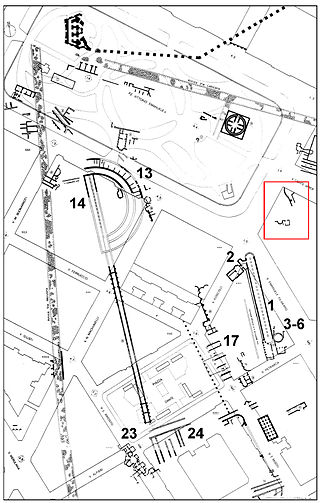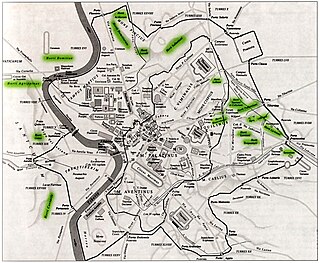Gardens
Ancient (Roman)

The Lamian Gardens (Latin - Horti Lamiani) were a set of gardens located on the top of the Esquiline Hill in Rome, in the area around the present Piazza Vittorio Emanuele. They were based on the gardens of the consul Aelius Lamia, a friend of Tiberius, and soon (by the time of Caligula) became subsumed into the imperial property.
The Horti Liciniani [2] were a set of gardens in ancient Rome, which originally belonged to the gens Licinia . In the third century A.D. they were the property of the Emperor Gallienus, [3] himself a member of that gens . The gardens were probably on the Esquiline Hill, at the top of which Gallienus erected a colossal statue of himself [4] The 4th-century domed nymphaeum that survives, long miscalled a "Temple of Minerva Medica", seems to have been part of the gardens.

The Gardens of Lucullus (Horti Lucullani) were an ancient patrician villa on the Pincian Hill on the edge of Rome; they were laid out by Lucius Licinius Lucullus about 60 BCE. The Villa Borghese gardens still cover 17 acres (69,000 m2) of green on the site, now in the heart of Rome, above the Spanish Steps.
Gardens of Maecenas , gardens built by the Augustan era patron of the arts Maecenas. He sited them on the Esquiline Hill, atop the Servian agger and its adjoining necropolis, near the gardens of Lamia.
The Gardens of Sallust (Latin : Horti Sallustiani) were Roman gardens developed by the Roman historian Sallust in the 1st century BC using his wealth extorted as governor of the province of Africa Nova (newly conquered Numidia). The landscaped pleasure gardens occupied a large area in the northwestern sector of Rome, in what would become Region VI, between the Pincian and Quirinal hills, near the Via Salaria and later Porta Salaria. This rione is now known as Sallustiano.
The gardens, which were enriched with many additional structures in the four centuries during which they evolved, contained many pavilions, a temple to Venus, a porticus of a thousand paces, and monumental sculptures. Items later found in the gardens include:
- the Obelisco Sallustiano, a Roman copy of an Egyptian obelisk which now stands in front of the Trinità dei Monti church in the Piazza di Spagna at the top of the Spanish Steps
- the Borghese Vase, discovered there in the 16th century.
- the sculptures known as the Dying Gaul and the Gaul Killing Himself and His Wife
- the Ludovisi Throne, found in 1887, and the Boston Throne, found in 1894.
- the Crouching Amazon, found in 1888 near the via Boncompagni, about twenty-five meters from the via Quintino Sella (Museo Conservatori).
The gardens were acquired by Tiberius and maintained for several centuries by the Roman Emperors as a public amenity. The Emperor Nerva died of a fever in a villa in the gardens in AD 98, and they remained an imperial resort until they were sacked in 410 by the Goths under Alaric, who entered the city at the gates of the horti Sallustiani. [5] The gardens were not finally deserted until the sixth century. [6] In the early 17th century Cardinal Ludovico Ludovisi, nephew of Pope Gregory XV, purchased the site and constructed the Villa Ludovisi, in the course of which several important Roman sculptures were rediscovered. Much of the area occupied by the gardens was divided into building lots and filled following the break-up of Villa Ludovisi after 1894, as Rome expanded as the capital city of Italy after the unification of Italy. The ancient topography itself has been irrevocably altered with the filling of the valley between the Pincio and Quirinal hills where these horti existed. [7]
The Horti Tauriani (Latin - Taurian gardens) was a large set of gardens in ancient Rome around the residence of Statilius Taurus, eminent character of the 1st century. They were perhaps the cause of his conviction for magic, which allowed Agrippina to confiscate them and add them to the imperial estates. They were then divided into different properties, were partly reunited under Gallienus in the mid 3rd century, but began to split again, in late antiquity being centred round the residence of Vettio Agorio Protested as the Horti Vettiani. From this area come numerous attributable sculptures from the Gardens's different phases : statues of deities, decorative reliefs, two large marble craters and three splendid portraits of Hadrian, Vibia Sabina and Salonia Matidia.

The nymphaeum called the Temple of Minerva Medica ("Minerva the Doctor") is a 4th-century ruin between the via Labicana and Aurelian Walls and just inside the line of the Anio Vetus. Once part of the Horti Liciniani on the Esquiline Hill, now it faces the modern via Giolitti. It is dodecagonal nymphaeum of opus latericium, whose full dome only collapsed in 1828. Both the interior and exterior walls were once covered with marble. [8] Since the 17th century the nymphaeum has frequently been wrongly identified with the Temple of Minerva Medica mentioned in literary sources, on account of the erroneous impression that the Athena Giustiniani had been found in its ruins. [9]
Other


Villa Ada is the largest park in Rome, Italy (450 acres/182 hectares). [10] It is located in the northeastern part of the city. Its highest prominence is Monte Antenne, [11] 67 m (220 ft), an ancient archeological site.
Villa Borghese gardens are a large [12] landscape garden designed in the naturalistic English manner in Rome, containing a number of buildings, museums (see Galleria Borghese) and attractions. It is the second largest public park in Rome (80 hectares or 148 acres) after that of the Villa Doria Pamphili. The gardens were developed for the Villa Borghese Pinciana ("Borghese villa on the Pincian Hill"), built by the architect Flaminio Ponzio, developing sketches by Scipione Borghese, who used it as a villa suburbana, a party villa, at the edge of Rome, and to house his art collection. The gardens as they are now were remade in the early nineteenth century.
The Villa Doria Pamphili is a seventeenth century villa with what is today the largest landscaped public park in Rome and enjoyed as a place of leisure by the inhabitants of Rome. It is located on the Gianicolo or the Roman Janiculum, just outside the Porta San Pancrazio in the ancient walls of Rome where the ancient road of the Via Aurelia commences. It began as a villa for the Pamphili [13] family and when the line died out in the eighteenth century, it passed to Prince Giovanni Andrea IV Doria from which time it has been known as the Villa Doria Pamphili
Villa Torlonia is a villa in Rome, Italy, belonging to the Torlonia family. It is entered from via Nomentana. It was designed by the neo-Classic architect Giuseppe Valadier. Construction began in 1806 for the banker Giovanni Torlonia and finished by his son Alessandro. Disused for a time, Mussolini rented it from the Torlonia for one lira a year to use as his state residence from the 1920s onwards. It was abandoned after 1945, and allowed to decay in the following decades, but recent restoration work has allowed it to be opened to the public. Part of the Torlonia family collection of classical sculpture is now housed at the villa.



















